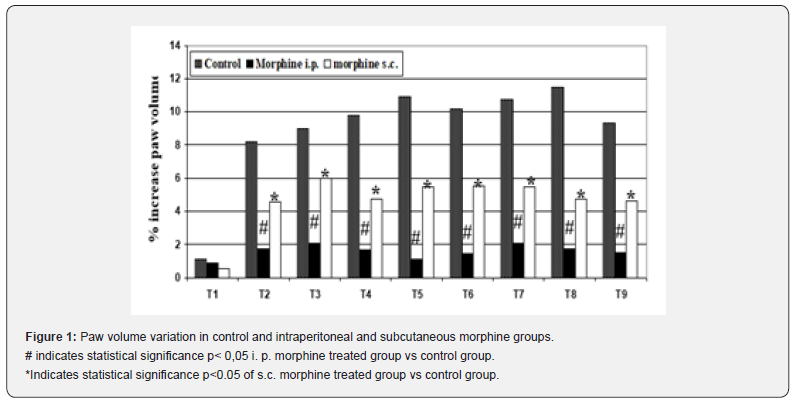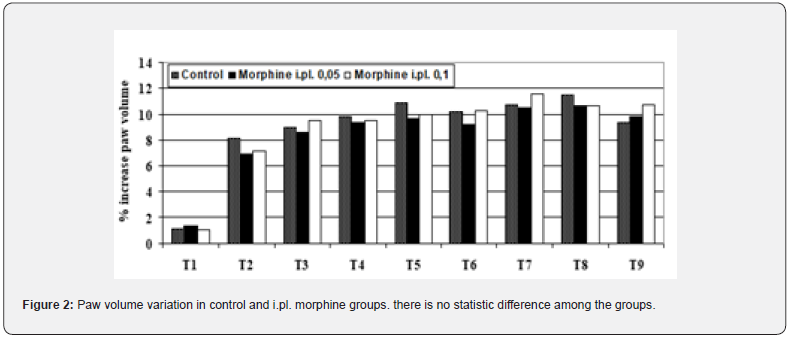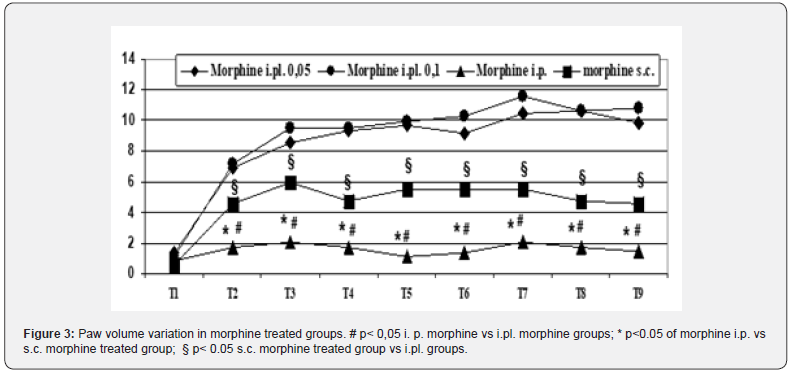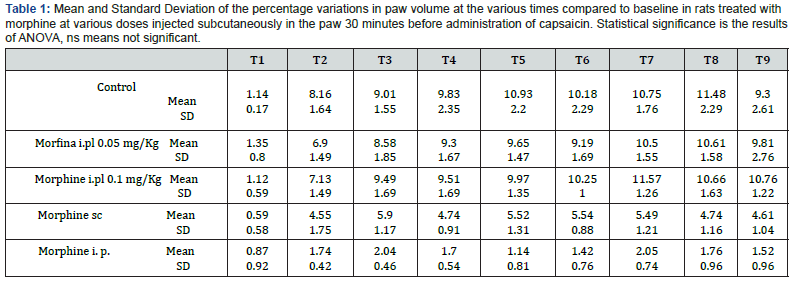Complementary Medicine & Alternative Healthcare - Juniper Publishers
Abstract
Peripheral opioids and analogues have demonstrated their efficacy in controlling inflammatory response and hyperalgesia. However, it is not yet clear whether the effect on edematogenic response is determined by the action at peripheral level or by systemic opioid receptors.
Methods: In this study we investigated the effects of subcutaneous, intraplantar and intraperitoneal morphine injection in rats with acute capsaicin-induced hind paw inflammation. The experiment was conducted on 50 male Sprague-Dawley rats randomly divided into 5 groups of equal numerosity. Group 1 was control group; group 2 was treated with 5 mg/kg morphine by intraperitoneal injection; group 3 with 5 mg/kg morphine injected in the back subcutaneously; group 4 and group 5 were treated respectively with 0.05 mg/kg and 0.1 mg/kg morphine locally injected in the paw before induction of neurogenic edema. Neurogenic edema was induced by the administration of 50 mcg capsaicin in 50 mcl saline in the paw. The edema was measured using a calibrated plethysmometer.
Results: Intraperitoneal injection of 5 mg/kg morphine 30 minutes before administration of capsaicin efficaciously inhibited the edematogenic response and statistically significant different variations in paw volume to the control group were measured at all observation times. The same doses of subcutaneous morphine reduced edematogenic response as well, even though to a lesser extent. Intraplantar morphine (0.05 mg/kg or 0.1 mg/kg) did not seem to have any effect on the edematogenic response at either dose or no significant difference was observed with respect to the control group.
Conclusions: the action of morphine on capsaicin-induced neurogenic edema appears to be related to a central rather than a local control mechanism.
Keywords:Morphine; Peripheral Opioids; Neurogenic Inflammation; Capsaicin
Introduction
Opioid peptides have demonstrated their efficacy in controlling inflammatory response. They exert their therapeutic action by binding to receptor sites in the central nervous system and to peripheral opioid receptors [21]. In the periphery the opioid receptors are located on sensory fibres and post-gangliar sympathetic endings [28], and on other non-nervous structures, such as vascular endothelium [4,19], immunocompetent cells as lymphocytes and macrophages [8], and keratinocytes [2]. The efficacy of endogenous opioids in reducing hyperalgesia and inflammatory response is extensively described in the literature [10]. Their anti-hyperalgesic and anti-inflammatory effect in experimental rat models [22, 28] has also been demonstrated by local administration of mu agonists, morphine, and fentanyl. Similar results have been observed with the intraplantar injection of tramadol, whose analgesic potency has been shown to be greater and more durable than treatment with lidocaine [9]. These effects are linked to tolerance and anti-hyperalgesic, anti-allodynic and anti-exudative actions are reduced when administration is prolonged [7]. Morphine’s site of action for edematogenic response is not well defined. According to some authors, morphine reduces neurogenic plasma extravasation induced by carrageenan with a mechanism, which does not seem to be dose-dependent, and this action is mediated primarily by peripheral opioid receptors [17]. Other authors report that activation of brain receptors inhibits carrageenan-induced edema, suggesting that the anti-edematous effect of morphine is due to action at central receptors alone (12). Sacerdote et al. [18] assessed the effects of a single dose of morphine (10μg) administered into the inflamed paw in a yeast model of acute inflammation and observed no effect on paw edema. Perrot et al. [13] administered morphine locally (50-200μg), both before and after intraplantar carrageenan, concluding that neither preventive nor curative administration of morphine could affect paw circumference.
The aim of this study is to test whether the preventive action of morphine on edematogenic response during acute inflammation capsaicin-induced is governed primarily by a systemic mechanism.
Materials and Methods
In this study we investigated the effects of morphine after subcutaneous, intraplanar and intraperitoneal administration in rats with acute capsaicin-induced hind paw inflammation. The experiment was conducted on 50 male Sprague-Dawley rats weighting 100-140 g (Morini Laboratories, Italy), randomly divided into 5 groups of ten animals each. Group 1 was the control group; group 2 was treated with 5 mg/kg morphine by intraperitoneal administration; group 3 was treated with 5 mg/kg morphine injected subcutaneously in the back; group 4 received 0.05 mg/kg local morphine in the paw before induction of neurogenic edema and group 5 was treated with 0.1 mg/kg local morphine in the paw.
Experimental Design
The study obtained the consent of the Committee for experimentation and was carried out at the Department of Experimental Surgery of the University of Padua. After mild anesthesia with ether, all the animals were given an initial intraperitoneal injection of 400 mg/kg of chloral hydrate, and, if necessary, received a supplemental dose of 30 mg of chloral hydrate. After anesthesia we shaved the right hind paw of all the animals using a hypoallergenic, non-irritant depilatory cream and made an indelible reference mark for the volume measurements. We then made the baseline measurement of paw volume. We treated all groups, except the control group, with morphine at the dose and by the administration route indicated in the protocol. Thirty minutes later we induced neurogenic edema by injecting 50 mcg of capsaicin in 50 mcl saline in the paw. The control group rats remained untouched for 30 minutes before the induction of neurogenic edema.
Measuring Paw Volume
We measured the edema with a calibrated plethysmometer (U. Basile, Mod 7150) [25], consisting in two interconnected Perspex cells filled with a specially prepared solution. This solution is composed of bidistilled water, 3g/l sodium chloride, and 5ml of a surface-active agent to reduce surface tension. The rat paw under study is dipped in one cell while the other cell, containing an electrode, detects variations in volume. A digital transducer indicates small variations in volume on a luminous display. We made three measurements for each recording and calculated the mean of the three values. The measurements were made before the start of treatment and every 15 minutes after induction of edema with capsaicin for two hours.
Statistical Analyses
The percentage variation with respect to baseline measurements at the various times was calculated for each group, according to the following formula:
%V = (Vbaset + n −Vbaset) /Vbaset ×100
The mean and standard deviation of the data collected for various treatment groups were compared with the controls. The statistical significance of the differences was calculated by variance analysis (ANOVA) and t-test.
Ethical Issue
The treatment of animals conformed to the guidelines contained in the “European Convention for The Protection of Vertebrate Animals Used for Experimental and Other Scientific Purposes” published on March 18, 1986, and successively modified by the European Commission and published in the European Official Gazzette, June 18, 2007.
The protocol was approved by the Italian Ministry of Health.
Results
Table 1 summarizes the results, given as mean and standard deviation (SD) of the percentage of variation of paw volume. As shown, the edematogenic response observed after administration of capsaicin in the control group reached its highest level after approximately 60 minutes, remaining stable for the entire duration of the experiment. Pre-treatment with systemic morphine inhibited the edematogenic response. Intraperitoneal administration of morphine (5 mg/kg) thirty minutes before inducing edema demonstrated its efficacy by inhibiting the edematogenic response: statistically significant differences between this group and control group were recorded at all observation times (Figure1).
The edematogenic response to capsaicin was reduced also in the group, which received the same dose of morphine (5 mg/kg) subcutaneously: also, this group showed a statistically significant difference (p<0.05) compared to the control group at all observation times, though the effect was less marked than the group treated with intraperitoneal injection (Figure 1). Intraplantar morphine did not seem to have any effect on edematogenic response at either administered dose (0.05 mg/ kg and 0.1 mg/kg), as no statistically significant difference could be detected when these groups were compared to control group (Figure 2). On the contrary a statistically significant difference was present when these groups were compared to rats treated either with intraperitoneal or subcutaneous injection (Figure 3).


Discussion
The results of our study seem to confirm that systemic morphine has a preventive effect on capsaicin induced edema. In fact, all the rats receiving 5 mg/kg morphine showed a reduced edematogenic response to capsaicin injection if compared to control animals. Intraperitoneal route seemed to be more effective than subcutaneous injection, maybe for a lower bioavailability of the latter due to slower absorption.s
Local intraplantar injection of morphine (0.05 mg/kg or 1 mg/kg) did show no preventive effect on edematogenic response to capsaicin. The effectiveness of local opioid administration in controlling pain of neurogenic inflammation is well documented and is due to opioid binding to receptors present on nervous endings of the inflamed part [20].


In the experimental model of the present work edema is due to the direct action of the irritant on the capsaicin-sensitive nervous fibers, which are small peptidergic neurons (50 μm) functionally corresponding to unmyelinated (C) fibers [23]. Capsaicin binds to the transient receptor potential vanilloid-1 (TRPV1) on primary nociceptive fibers and stimulates the release of substance P and calcitonin gene-related peptide [24] by a centrally mediated antidromic activity of Aδ and C primary afferent fibers [15, 16].
Dorsal root reflexes (DRRs) play a foundamental role for antidromic activity of small sensitive fibers during neurogenic inflammation induced by capsaicin. Capsaicin also exerts a direct action on small fibers: it elicits axo-axonic reflexes possibly contributing to inflammation at the site of injection [14]. So, peripheral administration of opioids can be effective in controlling pain but inadequate to prevent the reflex edematogenic response. As reported by Obara, in an experimental model of carrageenaninduced inflammation, the use of peripherically acting opioids, intraplantar morphine or 6-amino acid-substituted derivatives, elicits a potent, long-lasting analgesic response, but does not show any significant influence on the extent of the edematogenic effect [11]. Our results seem to confirm these data as local injection of morphine did not have any influence on the edematogenic response to capsaicin. Otherwise, the acute systemic administration of morphine can act on the tissue inflammatory response to surgical incision by modulating neutrophiles infiltration and cytokines accumulation in the tissue surrounding the surgical wound [5]. These results point to the foundamental role of central mechanisms in eliciting and maintaining neurogenic inflammation. The concept of preventive analgesia is based on the observation that an intense stimulation of the nociceptive primary afferent fibers, due to tissue damage and inflammation, increases the eccitability of the nociceptive spinal dorsal horn neurons so contributing to post-injury pain and hyperalgesia [3,6] and [27]. An early preventive action on the nociceptive inputs to the spinal cord decreases hypereccitability, hence pain and hyperalgesia. Therefore, the preventive use of systemic morphine exerts its analgesic effect and, by acting on neurons of the dorsal horns, modulates neurogenic inflammation triggered by capsaicin sensitive fibers through reflexes at this anatomical level [15].
The clinical implication of this observation is that preventive morphine may prove useful in the treatment of pain associated with inflammation, such as after surgery, in which the combination of these effects probably takes part to the observed improved functional recovery.
To Know more about Journal of Complementary Medicine & Alternative Healthcare
To Know more about our Juniper Publishers
Click here: https://juniperpublishers.com/index.php





No comments:
Post a Comment